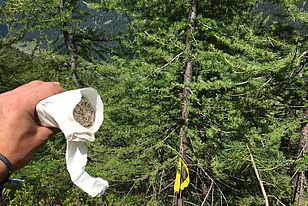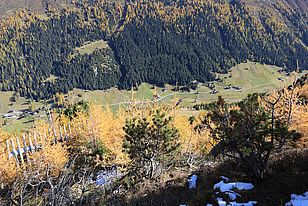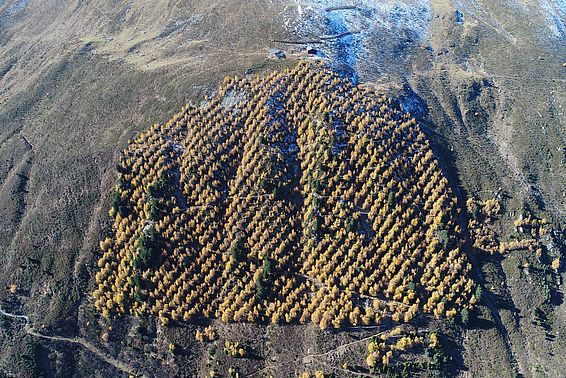A globally unique experiment led by SLF researchers has shown that even low nutrient input stimulates the growth of trees and dwarf shrubs in the treeline ecotone, altering the alpine ecosystem.
In principle, low temperatures (5°C and lower) are known to limit plant growth on the tree line, but now a long-term study has shown that even just a low nutrient input, e.g. by aerial means, can promote growth and thus influence the ecological balance.
Today, Switzerland's tree line lies at around 2,000 m. above sea level. This is the result of the so-called Little Ice Age in the 19th century and and agricultural use, including tree clearing until the middle of the 19th century. Since 1950, some 92,000 trees (Swiss stone pine, mountain pine, larch) have been planted on the SLF's 5-hectare (ha) Stillberg research site at an altitude of 2,000 m above sea level. On some parts of the Stillberg site, a research team led by SLF expert Christian Rixen conducted the first tree fertilisation experiment of its kind anywhere in the world on larch and mountain pine.
Over a 12-year period (2004-2016), the researchers input a relatively small quantity - 15-30 kg per hectare per year - of nutrients, including nitrogen (N). While larches reacted relatively quickly, showing increased growth after two years, mountain pines took longer, only starting to grow more after five to six years. Shrubs such as blueberries also responded to fertilisation after a few years, to increasing effect as the experiment continued.


The experimental fertilisation study on the tree line showed that:
- even just a low nutrient input to ecosystems, e.g. by aerial means, can influence the growth of plants on the tree line.
- The critical load – the measure indicating ecosystems' sensitivity to inputs and concentrations of air pollutants – in the transition zone (tree line ecotone) is less than 15 kg N/ha and year.
The results of this longitudinal study thus show that the alpine tree line is a very finely balanced ecosystem which reacts sensitively to low nutrient input. The aerial input of nutrients associated with global warming are likely to boost growth on the tree line.
Contact
Links and Documents
Original publication:
Möhl, P., Mörsdorf, M. A., Dawes, M. A., Hagedorn, F., Bebi, P., Viglietti, D., … Rixen, C. (2019). Twelve years of low nutrient input stimulates growth of trees and dwarf shrubs in the treeline ecotone. Journal of Ecology, 107, 768-780. doi.org/10.1111/1365-2745.13073
Copyright
WSL and SLF provide image and sound material free of charge for use in the context of press contributions in connection with this media release. The transfer of this material to image, sound and/or video databases and the sale of the material by third parties are not permitted.
